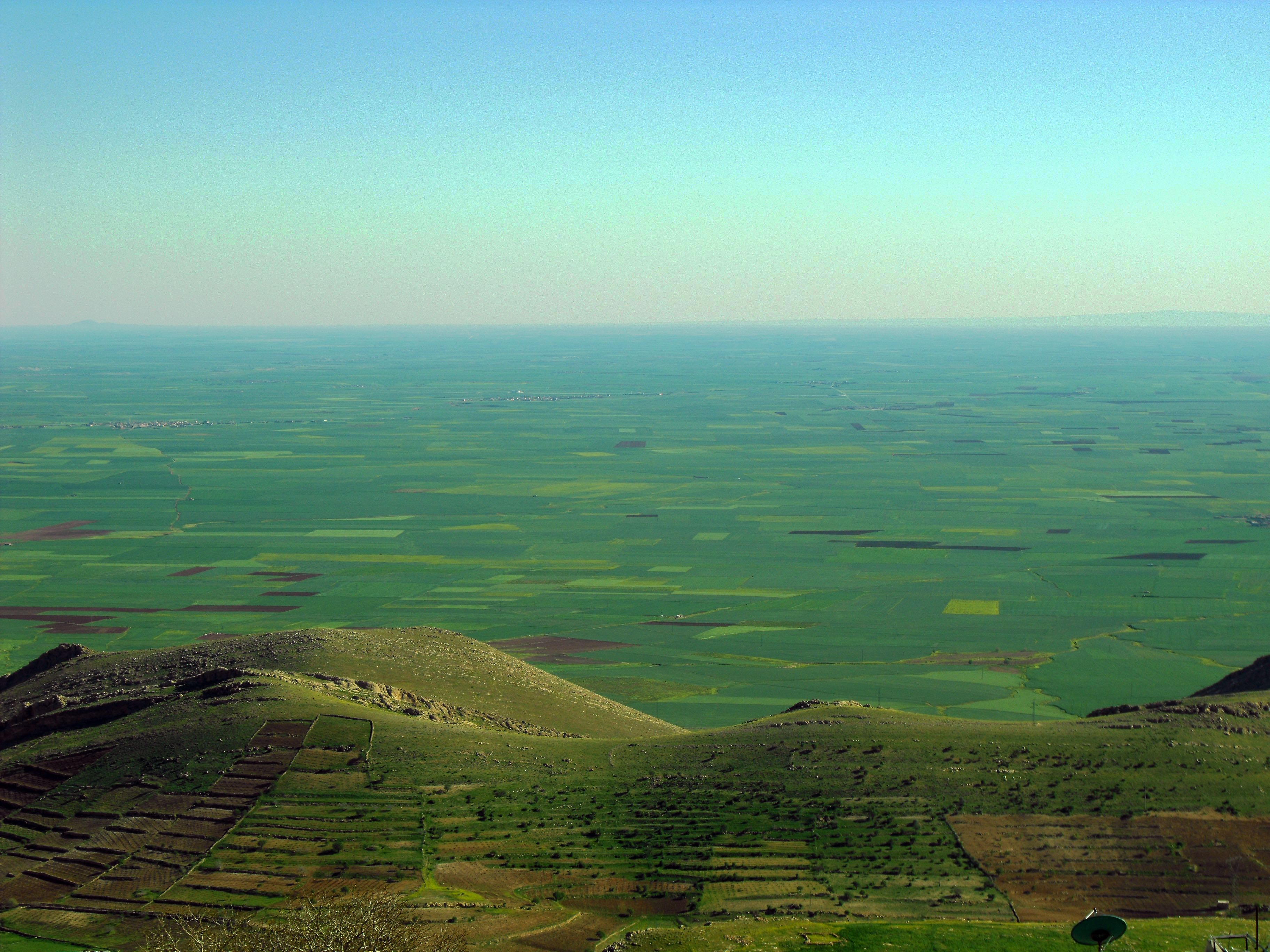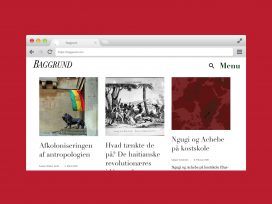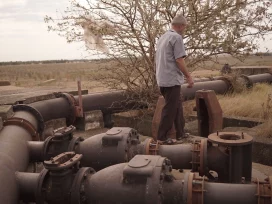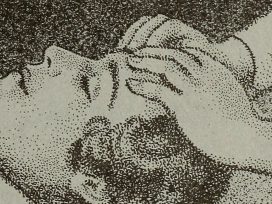The latest investigations respecting the early condition of the human race, are tending to the conclusion that mankind commenced their career at the bottom of the scale and worked their way up from savagery to civilization through the slow accumulation of experimental knowledge.
Lewis Henry Morgan (1877)
Around 10,000 years ago, human beings began to farm. In the history of both the planet and the human species, this is an incredibly recent development: between 95 per cent and 99 per cent of the lifespan of the human species took place before the development of agriculture. It’s that moment of transition – between the 99 and the 1 per cent of history – that has drawn the attention of both James C. Scott, in his new work Against the Grain, and of David Graeber and David Wengrow in their own piece for Eurozine, ‘How to change the course of human history (at least the part that’s already happened)’.
By returning to the moment of inception of the bureaucratic state, Scott, Graeber and Wengrow want their readers to question some foundational assumptions: that bureaucratic states naturally emerge from agriculture, that city-state living always represents an improvement over other ways of being, and that inequality is an inevitable by-product of the post-hunter-gatherer lifestyle. For Scott, the issue at hand is: how can we continue to embrace this idea of the city-state as improvement when the data suggests that picture is wrong? For Graeber and Wengrow, the question is: how did humans become so stuck in hierarchically organized states, when in fact early agricultural societies were experimenting with many forms of political and social organization, many of them profoundly egalitarian?
But where exactly do these wrong-headed assumptions come from in the first place? The challenge, for these authors, is that the claims they are trying to unpack come with their own complicated and multivalent histories. As terms, both ‘agriculture’ and ‘civilization’ have accrued a lot of meaning between now and the Enlightenment, and much of that meaning has been wrapped up with a project that neither Scott nor Graeber and Wengrow discuss directly: imperialism and settler colonialism. By tightly structuring their inventions in response to the ‘conventional story’, with its deep imperial roots, Scott and Graeber and Wengrow end up replicating its knowledge, its preoccupations, and its blind spots.
Depending on how you feel about the long-term survival of the species on a given day, it may be either cheering or depressing to realize that this last ten thousand year stretch of human history makes up only a very narrow band in the planet’s geological record, and that, as described by anthropologists Richard Lee and Irven DeVore in 1965, ‘stratigraphically, the origin of agriculture and thermonuclear destruction will appear as essentially simultaneous’. In Scott’s Against the Grain, agriculture and the bomb serve as the alpha and omega for what he calls a ‘thin Anthropocene’, marking a gradual acceleration of human influence on the face of the planet beginning from our species’ earliest efforts to shape our environment with animals, grain, and fire.
Against the Grain is meant as a revision and a corrective against the received belief (held formerly by Scott, as he details in the introduction) that early humans had begun to farm because it represented an improvement on hunting and foraging for food, and that this development of agriculture led to the creation of civilization, governance, art, written language, and public order, with ultimate benefits of improved health and more leisure time.
As Scott himself says, it turns out that this narrative is ‘wrong or seriously misleading’. Osteological analysis has shown that sedentary humans living with domesticated animals and farming domesticated plants suffered a significant decrease in health and wellbeing because of zoonotic diseases and a less diverse staple diet – and all this while working many more hours each day in the fields than they probably had while gathering plants or shellfish or small game from the surrounding land. There was a gap of several thousand years between the emergence of sedentary farming communities in the Fertile Crescent and the development of the earliest city-states in the same region.
And, once the state came into the picture, it did not represent an immense improvement in human welfare, but in fact expanded significantly the capacity for human misery through slavery and exploitative taxation. The best thing that a state could do was collapse. At least early states had the good grace to do this frequently – the Qin dynasty lasted barely fifteen years, while the Third Dynasty of Ur – a comparative paragon of stability – ran through five kings in one hundred years before collapsing. The so-called dark ages that followed liberated people to head out into the hinterlands and live according to their own lights, creating new cultural or social movements, or even had very little impact on individual communities at all.
In broad strokes, Scott’s narrative is compelling. He argues that grain production was perhaps not foundational but extremely well-suited to state production, since it could easily be assessed, gathered, and taxed. This feels, faintly, like a circular argument: states come from grains because grains grow where we see the earliest states. Demonstrably, rice production in China was taxed; it seems uncontroversial to talk about early Chinese dynasties as states on par with Ur, Sumer, Akkad, and the other well-known Fertile Crescent ancient civilizations. Equally, there’s evidence for concerted cultivation of maize in Mesoamerica and its dispersion to the southern reaches of North America by roughly 2100 BCE, but the prehistoric societies of Mesoamerica aren’t considered in this framework, even though maize would seem to be countable and taxable in a similar manner.

Plains south of Mardin, Turkey (2010). Photo source: Wiki Commons
In Against the Grain, readers are confronted with Scott’s efforts to disabuse us of our apparently deeply-felt commitments to the superiority of civilization and our antipathy to what he calls, tongue apparently in cheek, ‘the barbarian way of life’. It might be that my sixth grade World History and Ancient Civilizations class skipped over some stadial discourse content to have more time to model the Great Pyramids of Giza in gingerbread. (This is not a joke.) But the shadow-figure Scott seems to be addressing belongs not so much to the late twentieth century as to the eighteenth and nineteenth, when social theorists and colonial ethnographers alike sought to understand why some human societies looked different from others, and to explain why those other people should be rightfully classified as lower on the human developmental scale. Scott describes the inherited perspective on agriculture as such:
Agriculture replaced the savage, wild, primitive, lawless and violent world of hunter-gatherers and nomads. Fixed-field crops … were the origin and guarantor of the settled life, of formal religion, of society, and of government by laws. Those who refused to take up agriculture did so out of ignorance or a refusal to adapt.
Who was it that refused to take up agriculture? Partly, this answer depends on how you define ‘agriculture’. For two centuries, the received wisdom was that Aboriginal Australians and Torres Straits Islander peoples did not farm and had no agriculture. In fact, as Bruce Pascoe has demonstrated, the early European settlers record plenty of cases of Aboriginal people planting and harvesting crops, managing irrigation systems, and clearing cropland with controlled burning; these activities were just not recognized as agricultural by early colonial or subsequent observers because they didn’t look exactly like European cultivation practices. Archaeological surveying has turned up further evidence of what looks like yam cultivation and watercourse management all over the Australian continent at periods far back in the history of human settlement. Grain-based agriculture only predominated in parts of Eurasia, while what has been termed ‘garden agriculture’ was extremely successful in many parts of the world, including much of the Pacific.
But, more to the point, historically we have not answered the question ‘Who refused to take up agriculture?’ with ‘People who ran away from Sumer to live a more fulfilling and free life in the hinterlands with the barbarians’. Instead, we can find the answer to this question in the experiences of indigenous people around the world who were enslaved, murdered, or dispossessed so that their land could be farmed by settler colonists. Interest in the origins of civilization has never been purely historical. It has been grounded in European societies looking at other peoples in Asia, Africa, the Pacific, and the Americas and describing them as stuck in earlier stages of human development.
For many of the thinkers of the Scottish and French Enlightenment who addressed the stages of human social and political development, the indigenous people of the New World and Oceania were examples of the ‘lowest’ stage of human development – a model for the earliest stages of (European) universal human history. Jean-Jacques Rousseau’s 1754 ‘Discourse on the Origin and Basis of Inequality Among Men’ was frequently invoked by modern theorists in support of arguments about the inescapable nature of social inequality as a natural outcome of property accumulation and complex social organization. Rousseau was primarily engaged in a thought experiment, but in illustration of his points, he drew comparisons between the ‘historical Savage’ of prehistory and the ‘contemporary Savage’ of the Caribbean, who was still in the state of nature and therefore unburdened by the constant need of ‘civilized Man’ to move, sweat, toil, and otherwise put himself to work.
In his 1798 ‘Essay on the Principle of Population’, Thomas Malthus invoked the indigenous peoples of North America to describe the effects of a hunting-based subsistence model on population, showing that population is closely related to mode of subsistence, and that when nomadic hunters settle more permanently into fertile areas (or ‘near any European settlement’), population – measured by the number of children per woman – tends to increase. Malthus makes the argument that Scott is writing against: hunting is the beginning, and then humans progress through pastoralism towards agriculture, and experience substantial improvements in health and happiness with each new development. Certainly, as the rest of Malthus’ text makes clear, unchecked population growth that outran agricultural production threatened to plunge sedentary agricultural societies back into the misery and deprivation that he ascribed to hunter-gatherers, ‘the rudest state of mankind’, whose societies, as a result, could not ‘justly be called free and equal’. For eighteenth century observers like Rousseau and Malthus (who also disagreed on many points about the state of natural man), the most effective way to access the early history of human society was to look at contemporary people who they judged to be in the earliest stages of human development.
Prehistoric archaeology emerged as a field in the nineteenth century, beginning with the work of Danish antiquarian Christian Jürgensen Thomsen, who created the three-age relative chronology for categorizing prehistoric finds. Thomsen’s Stone, Bronze and Iron Ages were built on the study of a large body of prehistoric implements that had been excavated in closed sites across Denmark, which he sorted according to their material, their stylistic embellishments, and their stratigraphic placement. Thomsen’s categories were sometimes crude, but he was able to make a compelling case for the idea that these categories represented a chronological sequence, rather than several contemporaneous cultures working with different metals or stones. Thomsen’s work also sparked a larger efflorescence of Scandinavian prehistoric archaeology. By the 1840s, Danish archaeologists were excavating mounds of prehistoric shell and bone that had been discovered some distance from the coastline. They determined the mounds were kitchen middens from some long-ago prehistoric people, who had subsisted on shellfish and wild game during a period when the coastline came much further inland. Influenced by the work of Enlightenment philosophers – since not only Malthus and Rousseau, but also Adam Smith and Immanuel Kant wrote about the staged transition from hunting and pastoralism to agriculture, private property, and government – these European prehistoric archaeologists tracked the stages of development across their own field sites, even while they introduced new and more granular terms to distinguish different levels of pre-agrarian development.
In 1865, English naturalist John Lubbock subdivided the Stone Age in the Paleolithic (Old Stone Age) and Neolithic periods, based on differences in how stone blades were flaked, chipped, and polished; and in the latter half of the nineteenth century French prehistorians like Edouard Lartet and Gabriel de Mortillet introduced more subdivisions of Paleo- and Neolithic artefacts, describing their characteristics and naming them according to the sites where they were first found. Frequently, these terms from Paleolithic archaeology were applied to the tools and weapons made by living hunter-gatherer peoples elsewhere in the world and used to place them on a graded scale of cultural development. As Bruce Trigger has described, Aboriginal Tasmanians were claimed as an illustrative model of Chellean life, while Aboriginal Australians and Canadian Inuits were compared to the Mousterian and Solutrean lithic cultures, respectively. The Chellean culture, named for flaked stone tools found in Chelles, a small town to the east of Paris, was the earliest Paleolithic stone culture, succeeded chronologically and in complexity by the Mousterian and Solutrean.
In the early twentieth century, the prehistoric archaeologist V. Gordon Childe popularized the term ‘Neolithic Revolution’ to describe the transition to sedentism and agricultural production in ancient Mesopotamia. Childe is known today for being an ultra-diffusionist – a position he took in part because only a diffusionist explanation of culture change would allow European and Near Eastern finds to be placed on the same relative chronological scale, since absolute radiometric dating was still three decades in the future. Childe was also a committed Marxist; his attention to the changing conditions of social organization because of private property and agrarian production, not to mention his use of revolutionary terminology, makes even more sense in this context. In an article from 1950, ‘The Urban Revolution,’ Childe defines a revolution not as denoting ‘a sudden violent catastrophe,’ but instead as:
a culmination of a progressive change in the economic structure and social organization of communities that caused, or was accompanied by, a dramatic increase in the population affected – an increase that would appear as an obvious bend in the population graph were vital statistics available.
Thinking about this revolution in ancient Mesopotamia, Childe could draw on the new work of scholars like Robert Braidwood from the University of Chicago. Braidwood’s excavations at Jarmo and Hassuna, both prehistoric mound sites in Iraq, were investigating the causes of the transition to developing agriculture. Braidwood was among the first archaeologists to use radiocarbon dating and establish an absolute chronology for his different finds, which made it possible to make comparisons between different sites and, for the first time, to appreciate how much time had passed between different stages of sedentism or domestication in the archaeological record.
Braidwood and his coterie of mid-century archaeologists seem less relevant to Against the Grain than the legacy of ‘Western Civilization’, which dominated US college-level history teaching from the First World War to the 1960s. William H. McNeill’s History Handbook of Western Civilization, written in 1949 for an eponymous course at the University of Chicago, opened with the Paleolithic and Neolithic as necessary background to the rise of Classical civilization (i.e. Greece and Rome). The picture drawn of the beginnings of agriculture largely conforms to both the archaeological data of the period, and is not radically different from the new data Scott invokes – both common animals and crop plants were domesticated before the rise of the first city-states, villages may have moved frequently to new locations when local soil was exhausted, and it was only in particular locations where annual floods refreshed the fields every year that agricultural communities could remain in place year after year and eventually grow into the first urban settlements. This is a triumphalist narrative for both states and agriculture, after a fashion, but the foundational role of crop domestication is significantly muted compared to big historical narratives of the eighteenth and nineteenth century. Initially, I suspected that the counter-narrative Against the Grain was writing against might be found here, in the big picture world history writing of the mid-twentieth century; now, I’m less sure. There are many significant critiques that can be levied against a Western Civ course; an overly positive picture of agriculture is not one of them.
This intellectual genealogy is, admittedly, conjecture: I don’t know if Against the Grain truly means to address eighteenth and nineteenth century progressive civilizational teleology, or the Western Civ curriculum of the mid-twentieth century, or more recent work, or all of the above. Certainly, our knowledge of the past ten thousand years has been greatly strengthened through the past twenty or so years of excavations, and the increasing refinement of molecular and radiometric analysis has allowed certain questions about chronology and degrees of relationship between domesticates and wild species to be answered with much greater precision than ever before. Evidence, as well, will continue to be reassessed and reanalysed with fresh eyes. But even more importantly, there may be things about the deep human past that we can never truly know. Scott, no less than many of his intellectual predecessors, is filling in the gaps in the historical record with an imaginative reading of how human society might have worked, given these baselines and assumed conditions.
By setting this work as a reaction against prior interpretations, Scott ends up hewing closely to the preoccupations of his predecessors. Although he jumps around in time and place, he too often treats ancient Mesopotamia as a stand-in for prehistoric universal humanity, with the rest of the world pulled in at different moments to (often anachronistically) illustrate some example. A Khan Academy video on the Neolithic Agrarian Revolution, to pick one example, introduces viewers to a much larger history of domestication ‘firsts’ around the world, which seemed like a much more radical departure from the usual narrative of agriculture and the Big Four riverine civilizations. Scott is less interested in the exact specifics of life in the early Mesopotamian city-states than he is interested in what the broad outlines of these states allow us to say theoretically about state organization and the human condition. This is much more a work of political theory than it is prehistory scholarship, even though Against the Grain makes a plausible claim to be much better read in the most up-to-date prehistory than many (if not most) of its political theory fellows.
But the challenges remain, and although Scott works from a different political imaginary than many of his intellectual predecessors, he is still drawing big conclusions from a sparse evidentiary base. Scott has a good answer to this criticism: if the state produces all the records, then of course those records will provide stories that are favourable to the state. If historians limit themselves strictly to a certain type of textual evidence, the stories we write about the earliest Mesopotamian city-states will always skew towards the logics of state power, even when ecological and epidemiological evidence suggests that the picture may not have been so rosy for the average Sumerian or Akkadian.
It’s also possible that humans have been experimenting with multiple possibilities of social and political organization, and that the centralized city-state was only one of many arrangements that Neolithic humans explored. This is the conjecture that anthropologists David Graeber and David Wengrow examine in their own revisionist entry into prehistory, ‘How to change the course of human history (at least the part that’s already happened)’. Like Scott, Graeber and Wengrow begin with an Enlightenment shibboleth ripe for dismantling, in this case: ‘Inequality is a natural, unavoidable (if tragic!) consequence of civilization’. In response, they argue that the archaeological evidence suggests that farming didn’t lead immediately to irreversible and immutable hierarchical social forms; that the evidence for humans spending most of their time alternatively in single tiny bands is not particularly solid; and that early cities absolutely could be egalitarian in construction and makeup. Nothing about contemporary inequality is irreversible or can be blamed on the Neolithic (or, even worse, written off as an inescapable consequence of human nature).
The standard model Graeber and Wengrow describe is like an atmospheric phenomenon, omnipresent and difficult to grab hold of, although it sometimes condenses in places like the works of Francis Fukuyama and Jared Diamond, or possibly a high school world history textbook. Why does it matter if our fundamental conceptions of the beginnings of agriculture and sedentism in prehistoric Mesopotamia are wrong? Because, Graeber and Wengrow answer, this narrative defines our sense of political possibility, of what human societies might achieve. If we believe that we have been unable to arrange ourselves equally since the days of Ur, then what hope is there for a more egalitarian global human society in the far future? Alternately, if becoming egalitarian would require going back to a global population of no more than ten million people (circa 10,000 BCE) and living in small nomadic bands, then, again, equality sounds pretty impossible. ‘Abandoning the story of a fall from primordial innocence,’ argue Graeber and Wengrow, ‘does not mean abandoning dreams of human emancipation.’ Instead, by recognizing many different possibilities have existed in the past, we are freed to consider many different social and political arrangements in the future.
A point Graeber and Wengrow want to emphasize is that looking for the origins of modern social inequality in the Palaeolithic is probably futile. There is evidence for rich burials dating to approximately 25,000–15,000 BCE in many parts of western and central Europe. In southeastern Anatolia, the megalithic ruins at Göbekli Tepe – a collection of sixty-ton limestone pillars carved with ominous, bewitching bas-relief scorpions, lions, vultures, and erect male genitalia – suggest a massive workforce that gathered in one location over many hundreds of years but have been found without evidence of any permanent settlement or plant or animal cultivation. The obvious conclusion seems to be that Göbekli Tepe was a monumental worship site built by nomadic hunter-gatherers, but, as Graeber and Wengrow point out, the evidence is incredibly patchy. We might consider instead that Göbekli Tepe, Stonehenge and other monumental sites like them were part of a cyclical rotation, where humans lived in small bands at some points of the year and congregated together, with their animals and plants, in others. This might well be evidence of humans ‘self-consciously experimenting with different social possibilities’, right from the start.
On one level, Graeber and Wengrow are making a plea for non-specialist authors to do their homework better: to rely on the best standards of recent archaeological, genetic, and historical investigations and to provide concrete data rather than repeating just-so stories or reinscribing their contemporary prejudices and preoccupations in the Stone Age (a term that has itself largely fallen out of archaeological use). But they also argue this is a much larger issue, where even archaeologists will create expansive, detailed narratives about the social organization of prehistoric societies that take large imaginative steps in glossing over the lacunae in the archaeological evidence. Certain rhetorical moves, like referencing Eden and Rousseau (even when, as Graeber and Wengrow point out, ‘Rousseau himself never claimed the State of Nature really happened.’) crop up again and again because they’re part of the cultural framework that has evolved in the western cultural tradition to grapple with big-scale questions that are empirically virtually unanswerable.
Does deciding something is unknowable cut off the possibilities for ever going further? On the one hand, plenty of seemingly unanswerable questions may in fact be answerable, through reading sources for new insights and drawing on new data from allied fields; calling things off too soon cuts us off from those possibilities. On the other, accepting that something is probably unknowable frees us up to speculate and imagine many different possible explanations and arrangements. Some of those speculations may turn out themselves to be generative, because they force us to look at material anew and ask questions in a different way. We get into difficulties, though, when the speculation appears to take on solidity and surety of its own – in turn closing the opportunity for either a thorough examination of new evidence or the imagining of other possibilities.
This is part of the challenge of looking to prehistory and paleo-anthropology for deep insights into the modern human condition. We see our own concerns reflected in the Palaeolithic period as we piece together fragmented rocks, bones, and pieces of DNA. When we cannot answer a question, because the distances of time are vast, and the past is silent, we imagine possible ways to answer the question for ourselves, based on our best guesses and interpretations. These interpretations are inevitably also coloured by our training, perceptions and biases. Look at a century of Neanderthal dioramas in museums around the globe, and what will emerge is less a transcendent, fundamental truth about Neanderthal sexual and social organization, and more a reflection of the social and sexual mores of the period and place where the diorama was built. Our historical position creates conditions of possibility that change what we see when we stare into the dark and try to conjure shapes there.







